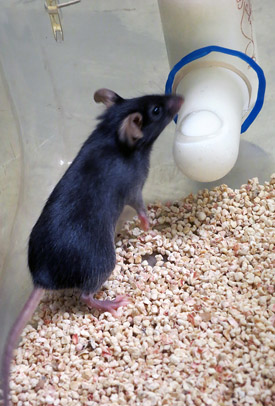New Methods
NIH Develops Improved Mouse Model of Alcoholic Liver Disease
Scientists may be better able to study how heavy drinking damages the liver using a new mouse model of alcohol drinking and disease developed by researchers from the National Institute on Alcohol Abuse and Alcoholism (NIAAA). The model incorporates chronic and binge drinking patterns that more closely approximate alcoholic liver disease in humans than any existing method. A report of the new model appears in the March issue of the journal Nature Protocols (1).
“The NIAAA model represents a significant advance in understanding the progression of alcoholic liver disease, which in severe cases can lead to liver failure and death,” said Kenneth R. Warren, acting director of the NIAAA. “By replicating both chronic and binge drinking, we are able to simulate the natural drinking patterns of many alcoholic hepatitis patients and the resulting liver injury.”

ERIN BRYANT, NIAAA
A mouse drinks a liquid diet containing alcohol. Scientists at NIAAA have developed a feeding method that allows them to better study liver damage caused by heavy drinking.
The liver, which filters out harmful substances in the blood, plays a key role in breaking down alcohol. Alcoholic liver disease (ALD) refers to a broad range of liver injuries caused by drinking. Some forms are mild and reversible while others, such as cirrhosis, are life-threatening and irreversible. Fatty liver disease, an early form of ALD marked by a build-up of fat in liver cells, occurs in almost all heavy drinkers, but liver damage can usually be reversed if the individual stops drinking.
About 20–40 percent of heavy drinkers will develop more severe forms of ALD, including alcoholic hepatitis, which involves inflammation and swelling of the liver, and cirrhosis, which can lead to liver failure as scar tissue accumulates in the organ. Scientists do not completely understand why some people progress to more severe forms of ALD, although sex, obesity, genetic and dietary factors, and smoking may play a role.
“Many of the models for alcoholic liver disease currently used do not evoke the full range of symptoms or are expensive and technically difficult,” said senior author Bin Gao, chief of the NIAAA Laboratory of Liver Diseases.
In the most common model currently used, mice are allowed to feed for four to six weeks on a liquid diet that contains five percent ethanol. But this model doesn’t induce the kind of liver injury commonly caused by binge drinking; it only induces mild fat accumulation in liver cells, slightly elevated liver enzymes indicating damage, and little or no inflammation. Models that are better at replicating more severe forms of ALD involve infusing alcohol directly into the mouse’s stomach, which requires intensive medical care for the animals, high technical expertise, and costly equipment.
The NIAAA model, however, is simpler. It involves a 10-day feeding of an alcohol-containing liquid diet, followed by a single high-dose feeding of alcohol to approximate binge drinking. This results in a marked elevation of fatty liver and enzymes indicating liver injury.
“The NIAAA model is less costly, more time efficient, and easy to perform,” said Gao. “Importantly, it may more closely resemble the progression of human alcoholic hepatitis.” He noted that it may also be useful in studying damage to other organs caused by heavy drinking, including the heart, lungs, kidneys, pancreas, and central nervous system.
1. A. Bertola, S. Mathews, S.H. Ki, H. Wang, and B. Gao,“Mouse model of chronic and binge ethanol feeding (the NIAAA model),” Nat Protoc 8:627–637, 2013. [http://www.nature.com/nprot/journal/v8/n3/full/nprot.2013.032.html]
This page was last updated on Thursday, April 28, 2022
